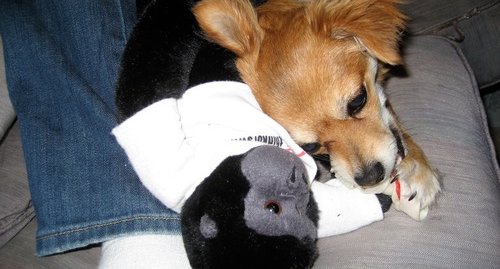By
Mark DiMassimo | 08/16/2017 | in
The following post is an excerpt from Digital@Speed, authored by digital marketing guru Mark DiMassimo. Visit the official website here to download your free copy today.

Ernest Hemingway is said to have created the shortest short story ever. Over lunch at the Algonquin Round Table in New York City, Hemingway bey his writer friends he could write a compelling tale in only six words. His lunch mates happily bet $10 each that he couldn’t do it. Hemingway scribbled six words on a napkin, then passed it around. Each writer read the napkin and immediately conceded Hemingway had won. The six words: “For sale. Baby shoes. Never worn.”
At DiMassimo Goldstein, we could say, “We’ll get you to a better place and we’ll get you there quicker.” But we say, “Higher standards. Shorter runways.”
So let’s not ever make each other guess which part of a brief is the important part. Let’s just include the important part. Let’s make sure our briefs are simple, compelling and crystal clear. Nothing in an agency is more sacred. – From the DIGO Standard .
I like to think that it’s called a brief for a reason. This is not about “minimalism” or some fetish for curtness. Before a brief can be a tool for getting the right creative work or media thinking out of a team, a brief is a tool for getting thoughts focused. Focused thinking is elegant. An elegant solution is everything that is necessary to solve a problem, and not one thing more. Looking at it from the other directions, you want it as simple as possible, but no simpler.
Think problem/solution. Question/answer. Stimulus/response. Just as listening well is essential to communicating effectively, defining the problem is essential to creating a solution.
By
Mark DiMassimo | 07/26/2017 | in
The following post is an excerpt from Digital@Speed, authored by digital marketing guru Mark DiMassimo. Visit the official website here to download your free copy today.

What do you believe about people? What do you think they work for? What motivates them?
You have a people theory whether you know it or not. No one could long survive in a society without some operating theory of what will work in interactions with other people.
When I was in college, I interned at a psychiatric hospital on the acute care ward. People came in at their absolute craziest. Sometimes they were truly stark raving mad. But for the most part, these people were successful more than half of the time in navigating interactions with other people.
On the other hand, even the most successful don’t have perfect social records. They misjudge people or themselves. They make mistakes.
They too have people in theories in action.
A leader should be as conscious of his or her people theory as possible. Look for your patterns. Write stuff down. Question your assumptions. It’s not easy, but it’s less painful than expensive mistakes.
By
Mark DiMassimo | 07/24/2017 | in
The following post is an excerpt from Digital@Speed, authored by digital marketing guru Mark DiMassimo.

I love game changers. They drive the world forward. They are the natural force in national selection. They are the good guys of business. And I want them to win. I want them to end up on top.
But, often they don’t. Because game changing and game winning don’t automatically go together. Think about it this way: Innovation creates a window of opportunity. The window opens with the introduction of the change. It closes when the new way is copied, tweaked, improved and deployed by the competition.
What the game changer does between the opening and the closing of that window is everything. If you move quickly to own the change, to own it in the marketplace, to own it in the minds of your target audience, then you make it much more difficult for your much larger and richer competitors to co-opt that innovation.
Between the opening and closing of the window, there is DIGO.
By
Mark DiMassimo | 07/14/2017 | in

We marketers spend so much time on our marketing, we can be forgiven for thinking that it’s the first and last word about the brand.
Perhaps there was a time when this was more or less true. Not today.
Today, the conversation about brands, services and products is never more than a couple of clicks away. People have more tools than ever to find out what other people really think about the things we sell. Advertising is a smaller and smaller part of the conversation.
That’s why an integrated growth plan must start with the behaviors and beliefs of the audience. It needs to embrace the entire brand experience. The customer journey becomes the road map. By prioritizing the touch points with the greatest leverage, real results improvement can often be achieved in short order.
So, what about the 57%? That’s the part of the buying process that a prospect typically engages in before they talk to someone from the company. The other 43% is important, but the whole 100% is where the winners play.
By
Mark DiMassimo | 07/14/2017 | in

People pay us to get people to do things.
Isn’t that what you get paid for too?
Think about it. Whether you’re making a product, delivering a service, designing, marketing, innovating or financing – doesn’t the result happen only when you get people to actually do something different?
Actions are the fundamental currency. No actions, no cash.
So, success in business – and in achieving any worthy end – is a battle between manipulation and inspiration.
Manipulation is when we use tricks to get people to do things.
Inspiration is when they do those things because those things are meaningful and satisfying to them.
A business can be built on manipulation for a while. Offers. Urgency. Price manipulations. Sales. Scarcity. Emotional hyping. There is a whole business literature of tricks. Direct and interactive marketers have proven them. Persuasion designers have honed them. Behavioral economists have proved them in double-blind studies.
Manipulation works. For a while.
But manipulation doesn’t satisfy. In fact, it sucks meaning. Organizations that rely too heavily on manipulations build a house of cards, without coherence, loyalty or passion.
Inspiration, as Simon Sinek has said, starts with Why.
When people are doing because they are inspired to do, they value their own actions differently. We saw this when we attracted more customers for an online broker by offering a stuffed monkey (really) than by offering $350 dollars cash, just for signing up.
The monkey meant, “I’m in this crazy tribe.”
The money meant, “I’ll take the bribe.”
Which do you think acquired more valuable customers? Correct. The monkey.
Which do you think acquired more customers in the first place? Also, the monkey.

Most people are surprised by that. Knowing all I do about inspiring action, I was also surprised.
This broker built an incredibly powerful and valuable brand. It inspired passion that converted into fast growth, intense engagement and rock solid loyalty.
Want a metric to measure and manage this by? Call it your Inspiring Action Quotient.
How much do you lead, market, attract, convert and build through Inspiration? That’s the numerator, the number on top.
How much do you manipulate in order to generate the actions that grow your business? That’s the denominator.
Inspiration over Manipulation.
Inspiration/Manipulation = Inspiring Action Quotient
The higher your score, the more brand value you’re building, the brighter your future.
Simple and difficult as that.
Now let’s inspire some action.
By
Mark DiMassimo | 05/27/2017 | in
The following post is an excerpt from Digital@Speed, authored by digital marketing guru Mark DiMassimo. Visit the official website here to download your free copy today.

Apple. Virgin. Southwest. JetBlue. Crunch. Snapple. Groupon. BlueFly. Zappos. The Motley Fool. What do these brands have in common? They’re challengers, and successful ones at that.
They’ve mastered the art of zagging where others have tended to zig. They’ve taken on the goliaths of their industries and come out on top. The truth is, it’s a challenging world out there, and every marketer these days needs to be a successful challenger or go down.
Market leadership doesn’t create an exception. Look at Citibank and IBM, for example. By becoming their own best competition, they’ve looked like ready challengers, reinvented their businesses and continued to grow.
Here’s what challengers do differently:
1) The top dog is INVOLVED. Intimately.
Some folks think the reason they got degrees and big titles was so that they could independently run their own empire. Some of these people are actually pretty smart. But nine times out of ten, this attitude will do them in.
A boss is not a meddler to be avoided. If you were playing chess, you wouldn’t leave your Queen in the background and try to fight it out endlessly with your lesser pieces. Or would you?
Forget the org chart. Every player on the board is on your team. Use them!
If you want to make things happen @speed, you want the least distance between you and your boss. And you want to access the power your boss has to smooth situations and to make good tactical decisions into great strategic initiatives. Plus, you want the power to change things that you’re not personally responsible for, because changing those things will make all the difference in your ability to create success. So, you bring your boss in as a collaborator and ally. As much as possible, you lead hand in hand. It’s the challenger’s way to use every last person.
2) The advertising conversation and the business conversation are THE SAME CONVERSATION.
Don’t separate what you’re doing from why you’re doing it, even for a moment. You never want to be the one saying, “But we failed with work that was on the strategy we were given!” That is a level of responsibility, but it’s the wrong level.
You want to be responsible for the success of the enterprise. You want the brand and business to reach its full potential. You want to use not just your authority but your influence. Because nothing beats being a part of something great and you don’t want to leave that to chance.
In this context, great advertising is advertising that works for the business and brand. It brings the business strategy to life. It creates the connection that reflects the intentions of the business while both suggesting and fulfilling its promise.
This is where experience meets selling meets branding.
3) The work is seen as the ultimate weapon for conquering the competition.
Where is the unfair advantage to be found? You are not in a position to outspend. You’re not going to break the law. Or trying to change it to favor you. But you can pack more power into the product, the packaging, the service, the story, the propaganda. You can be smarter about the technology, the testing strategy, more ingenious and industrious about the optimizations.
You can win it in the marketplace of ideas. So, do that.
4) The brand is seen as a precious asset and the ultimate defensive fortification against copycats and commoditisers.
Challengers build unique brands and they value them above all else. Customers are intensely loved, but they come and go. Employees are highly valued, but the sort who are attracted to a challenger business can only be held by a great brand. A unique culture and point of view is often the only thing to hold onto in the perfect storm of growth.
A brand is armor and a full tank of gas. A brand is everything. And you only need a business to build one!
5) The VISION of the top dog drives the advertising.
Steve Jobs met every other week for intensive sessions with Lee Clow, the creative chairman of his advertising agency. In the most successful challenger businesses, the vision for the brand and advertising comes from the top. No question about it.
That kind of courage and purity of vision can’t be bought. It can’t be outsourced. No committee could sustain it. For a business that has its founder to get the full advantage of that fact, the vision must be owned and driven from the top.
6) The vision of the agency and the vision of the client are complimentary and synergistic.
The mutual inspiration society should include client and agency, vigorous discussions, sharing inspiration, lots of choices, and plenty of going back to the well.
The most sophisticated team wins.
7) Decisions get made in meetings, not just in between.
In big, bloated bureaucracies, meetings only ratify decisions that are made elsewhere. Which is why most people in those places feel that there time is wasted in meetings. Because it is.
But you don’t have time to waste. So you’re not going to protect your own ego or anyone else’s by pretending for a second to agree with what you don’t. You’re going to have real conversations. In front of whoever is there. And when some people complain about that and they try to negotiate with you to stop the open, inclusive, challenging, passionate dialogue, you are going to say, “I understand how you feel. And, no. Absolutely not. Because that would be replacing occasional discomfort with the endless pain of mediocrity and failure. Which you wouldn’t tolerate for long… you’d be gone. So, no! Let’s just agree to be respectful to each other, to put the good of the work first, and to say exactly what is on our minds.”
By
Mark DiMassimo | 05/21/2017 | in

Many people have learned to start a fire from the bottom, with kindling and firestarters underneath, then small twigs, and larger wood on top.
Expert firestarters will tell you to reverse that method – for more certain results, start with the top.
Brands built around a powerful emotional match – a single emotional strike zone ignited by a powerful emotional idea that sits above and informs every brand touchpoint – tend to grow faster and burn hotter.
Many marketers try to build a cohesive brand and a self-perpetuating business through offers, promotions, personalization and other performance marketing techniques. Starting from the bottom creates an unruly fire that needs constant tending and that often fails to achieve the integrity and heat of a self-perpetuating blaze.
Starting from the bottom leads to a common marketing malady –the balkanization of target.
Today personalization and micro-segmentation are all the rage. Performance marketers have built a multi-billion dollar industry, but much of the value they capture in the short-term is at the cost of the long-term brand and enterprise value of their clients.
Make no mistake, igniting action is essential to the creation of value, but action at the cost of brand is unsustainable and irresponsible.
Often the process of building a sustainable and growing blaze starts with putting the brand back together again.
Starting with key segments and personas, the successful marketer looks for a singular “emotional strike zone” – a common emotional target that is shared.
The “emotional match” is the key idea or purpose that strikes that target and ignites passion.
The process looks like this:
Segments and personas -> Emotional Strike Zone -> Emotional Match
Once the team understands the emotional strike zone and the emotional match, attention is turned to accelerating the actions that create value and growth for the brand and business.
When you start from the top, you build a marketing blaze that becomes self-perpetuating. You set it and feed it and the heat does more and more of your work for you. Does it really work? Check out some of our clients’ recent public results.
By
Mark DiMassimo | 05/04/2017 | in

Agencies are split. They are bifurcated, balkanized.
Advertising from sales promotion. Creative from media. TV from digital. Brand from business. Consumer from B2B. Social from experiential. Strategy from execution. Content from Identity from Innovation.
Each responsible for their deliverable. None accountable for the client’s success.
And paid to treat decision makers as if they’re split too.
Rational vs. emotional. Buyers vs. brand users. E-mail responders vs. mobile app users.
But decision makers aren’t split. They’re whole human beings. Hearts and minds together. Real people who think for themselves and are susceptible to social influence as well.
Whole people who respond to whole brand experiences. Amazing, coherent, inspiring brand experiences that move them to engage, to hope, to trust, to desire, to share, to dream, to buy and to bond.
The experiences you create, and the purpose and meaning behind them, are what people talk about. They share, rate, report and buy experiences, and as they do, reputations are formed.
We have lived on the split side, worked in those agencies, large and small, every one of us as experts in our own silos, cut off from the whole.
We each chose the whole brand experience. The integrated, cross-trained team. The challenge of collaborating with the client to create the whole solution.
Here we are gladly accountable for the deliverables, but equally we are anxious to share accountability for your reputation, your brand and your growth.
We help our clients inspire people to make more inspiring decisions and form more empowering habits, connections and partnerships.
We work to be worthy of that whole partnership, and we’re as proud of our results as we are of our work.
Because today, your brand isn’t what you tell people it is. Your brand is what people tell people it is.










